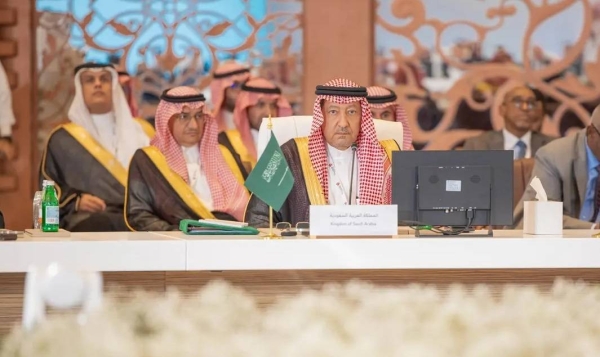
LONDON: Born in 1897 with a name that spoke to centuries of high breeding, Englishman Gerald Simpson Hillairet Rutland Vere de Gaury was in many ways typical of his class and generation. As such, he appeared destined for a career in the civil service after a stint in uniform.
However, a brush with death as an 18-year-old in the British army during World War I diverted de Gaury from that well-worn path toward a lifetime’s fascination with Arabia.
Classically educated at Oxford, he was commissioned into the British army as a lieutenant at the outbreak of the war. Decorated for his bravery, he was wounded four times while serving at Gallipoli and on the western front in France.
Pages from the book “A Saudi Arabian Note Book” by Englishman Gerald Simpson Hillairet Rutland Vere de Gaury. (Supplied)
While convalescing from wounds that almost claimed his life, he decided to teach himself Arabic. In the process he developed a passion that would lead to him to become one of the first Britons to visit Riyadh and the court of King Abdul Aziz (Ibn Saud), the founder of Saudi Arabia, and to write what was probably the first guide to the Kingdom for tourists.
De Gaury wrote several books about the Arab world and its rulers, including “Three Kings in Baghdad: The Tragedy of Iraq’s Monarchy,” the biography “Faisal: King of Saudi Arabia,” and “Arabia Phoenix,” which was published in 1947 and includes an account of his first meeting with Ibn Saud, in 1934.
But his first book, a limited edition of which was printed in Cairo in 1943, was “A Saudi Arabian Note Book,” a guide for foreign visitors. Until recently, only five copies were known to exist. One is in private hands, having surfaced at auction, and the others are held by the New York Public Library, the US Department of State, the National Library of Israel and the Orient-Institut in Beirut.
Now, even as as the Kingdom opens its doors to international visitors as never before, a sixth copy of the book is about to be offered for sale for £12,500 by Peter Harrington, the London rare-books dealer.
As de Gaury wrote in his foreword to the book, which includes 39 of his own photographs, in the early 1940s Saudi Arabia was “still a closed country to all but a few foreigners invited there by Ibn Saud…Photography is still unwelcome to many of the inhabitants, and it was only after receiving special permission that the photographs in this book were taken.”
Visitors, he added, “depend upon the hospitality of Ibn Saud and it was only through his kindness that I have been able to put together these few notes, which are by no means exhaustive, but may be of use to other travelers.”
De Gaury’s respect for, and deep knowledge of, Arab culture is reflected in the cover of the book, which features an illustration of the star cluster Pleiades (Al-Thurayya in Arabic). It is possible it was drawn by the author himself, as he was an accomplished artist.
The book is important, said Raphael Cormack, a specialist researcher for Peter Harrington Rare Books. (Supplied)
The book opens with a transcription of “To the Pleiades,” a poem attributed to 18th-century Najdi poet and stargazer Rashiud Al-Khalawi. The cluster of stars, de Gaury writes, “represent to the Bedouin of Arabia the annual renewal of life, the winter rains, the spring showers, which bring once more sap into the bushes on the desert, and life into flowers and man.”
The book is important, said Raphael Cormack, a specialist researcher for Peter Harrington Rare Books, partly because it was de Gaury’s first but also because “it is one of the first attempts to create a guide to Saudi Arabia for visitors — an early attempt to describe the country to the outside world.”
It is clear from de Gaury’s writing that, like a number of British contemporaries, he was irresistibly drawn to the Arab region and its culture.FASTFACTS
IN NUMBERS
* 6 Known copies of "A Saudi Arabian Note Book" in existence.
* 39 Photographs in the book.
* 50 Pages of text.
* 12,500 Price of the book in pounds sterling.
“He feels the draw of the Middle East like so many of those people, and he knew many of them, including Freya Stark, Wilfred Thessiger and St John Philby,” said Cormack. “He must also have known Gertrude Bell, because they were in Iraq together.
“As with quite a lot of these British travelers, there’s a sense in his writing that the Arabs and the Brits are somehow similar in outlook.”
De Gaury left no record of how his interest in Arabic and the Arabs began. It seems likely it might have been triggered by his experiences as a young soldier on the Gallipoli peninsula in 1915, where more than a third of the Ottoman troops, who drove the British and their allies back into the sea after eight months of bloody fighting, were Arabs.
As de Gaury wrote in his foreword to the book, which includes 39 of his own photographs, in the early 1940s Saudi Arabia was “still a closed country to all but a few foreigners...” (Supplied)
De Gaury fought bravely at Gallipoli and, later, the Somme, where in 1917 he was awarded the Military Cross, a medal given to British officers for outstanding acts of courage.
As a citation published in “The London Gazette” in July 1917 noted, he “displayed the greatest gallantry…although subjected to heavy machine-gun and rifle fire, he captured an important enemy post. His fine example and disregard of danger were of great value to his men.”
That disregard for danger contributed to him being wounded four times, as recalled in his obituary, which was published in the journal Asian Affairs in 1984.
De Gaury left no record of how his interest in Arabic and the Arabs began. It seems likely it might have been triggered by his experiences as a young soldier on the Gallipoli peninsula in 1915. (Supplied)
“On one occasion he lay out all night in the barbed wire, surrounded by dead men, and narrowly missed having a leg amputated on admission to military hospital,” wrote his friend, fellow Arabist and author Molly Izzard. “He bore with stoicism discomfort from these wounds throughout his life.”
De Gaury, Izzard added, “liked, and was liked by, the Arabs”. A “man of action…with an enquiring mind and an imperturbable manner…soldierly, of distinguished carriage and appearance”, there was “a forthright quality about him which appealed to them.”
De Gaury’s love affair with Arabia began after the war when he passed an interpretership exam in Arabic with the British Civil Service Commission.
De Gaurys first book, a limited edition of which was printed in Cairo in 1943, was “A Saudi Arabian Note Book,” a guide for foreign visitors. (Supplied)
This led in 1923 to a secondment from the army to the Iraq Levies, an Arab force set up to guard Royal Air Force bases in what was then still a British mandate. In reality, as de Gaury’s service record reveals, his posting had little to do with guarding airfields; his assignment was “intelligence duties.”
As a soldier-diplomat-agent in the Middle East, he developed a professional interest in, and eventually a personal friendship with, Abd Al-Ilah of Hejaz, the regent of Iraq from 1939 until 1953, when King Faisal II came of age.
The relationship ended in tragedy in 1958, when Al-Ilah, the king and many members of his family were murdered during the revolution that overthrew the Iraqi Hashemite dynasty that had been installed by the British in 1921. De Gaury composed and delivered the eulogy for the king and his family during a memorial service in the Queen’s Chapel at the Savoy in London in July 1958.
De Gaury wrote several books about the Arab world and its rulers. (Supplied)
It speaks volumes for de Gaury’s character that, despite the historical differences between the houses of Saud and Hashim, he was able also to cultivate a friendship with Ibn Saud, who founded Saudi Arabia and became its first king in 1932.
They met in 1934, when de Gaury became one of the first Britons to visit Riyadh. In March 1935 he was appointed attache to Sir Andrew Ryan, the first British minister to the Saudi court in Jeddah. That same year, de Gaury returned to Riyadh, this time with Sir Andrew, to present Ibn Saud with the Grand Cross of the Bath, a gift from King George V.
De Gaury’s next appointment in the region was as British political agent in Kuwait from 1936 to 1939, during which time he again visited Riyadh as special emissary to Ibn Saud.
De Gaury’s love affair with Arabia began after the war when he passed an interpretership exam in Arabic with the British Civil Service Commission. (Supplied)
There is no record of the Saudi king’s opinion of de Gaury, but the fact he invited the Englishman to accompany him on long trips in the desert, during which they hunted gazelle, bustard and hare with hawks and Saluki, suggests the two men got on well.
They were certainly comfortable in each other’s company. In “Arabian Journey,” published in 1950, de Gaury recalled being teased by the king. “In reality I abhor all foreigners,” Ibn Saud told him. “I would have none of them. The best of them are the British and I would that they were on the far shore of a sea of flame and fire.” The king, noted de Gaury, “said it without rancor or ill humor and smiled.”
Soldiers both, the men shared a special bond to which de Gaury alluded in “Arabia Phoenix:” the marks of battle, sustained by the Briton during World War I and by the king as he fought to unite the territories that would become Saudi Arabia.
De Gaury and Ibn Daud met in 1934, when de Gaury became one of the first Britons to visit Riyadh. (Supplied)
The king’s right hand, de Gaury wrote, “is scarred from an old wound, received at the battle against the Turks and his Rashidi rivals at Al-Baikairiya. On the field of Qanzan, in battle with the Ajman tribe, he was wounded over the right thigh. When the weather changes suddenly, when the winter winds come sweeping down from the Taurus after the summer heat, he sometimes has from this the aches old wounded soldiers know.”
Such was the trust that grew between the two men that when Prince Faisal, the future Saudi king, was sent to London on a diplomatic mission in Nov. 1943, at the height of World War II, Ibn Saud approved de Gaury’s appointment as his liaison and interpreter for the trip.
In “Arabia Phoenix” de Gaury revealed that his visit to Ibn Saud in Riyadh in 1935 had an ulterior motive. “While we were there,” he wrote, “we might be able to see and hear enough to know whether the new state (Saudi Arabia) would endure or fall.”
Some of the crown princes depicted in de Gaurys book. (Supplied)
In 1946, as oil began to carry the Kingdom toward a new and uncertain future, de Gaury felt this issue remained in the balance.
“Since the days of the Prophet Muhammad,” he wrote, “there has been no more important moment in Arabian history than now. How sturdily will she face her dilemma? Her secrets from the past and civilization of two thousand years ago are not forgotten, but must she abandon them in order to receive advantages of another kind from the West?”
De Gaury witnessed the early stirrings of the modern Saudi Arabia, and recorded some of them in “A Saudi Arabian Note Book.” (Supplied)
Although he witnessed the early stirrings of the modern Saudi Arabia, and recorded some of them in “A Saudi Arabian Note Book,” de Gaury could not have imagined the rapid transition and modernization that is under way in the Kingdom now.
And yet, in the closing words of “Arabia Phoenix,” a book named for a bird that in ancient legend rises from the ashes of its former existence, de Gaury offered a prediction that, almost four decades after his death, has come to pass.
“Arabia and the Arabs are now astir,” he wrote. “He who visits the Arabian lands may yet see again that wondrous rare Arabian bird — a Phoenix.”
---------------------
@JonathanGornall












